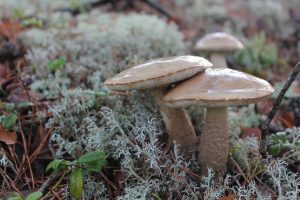Lichens
Lichens are organisms that arise through a symbiotic relationship between a species of fungus and a species of photosynthetic bacterium or alga. There are more than 15,000 different kinds of lichens. Some look like a flaky crust growing on rocks and trees. Some are flat and leafy looking. Lichens are an important part of Arctic vegetation as they are less affected by the coldness of these areas compared to many other organisms. In dry areas especially, they are a dominant group of organisms that contribute to a major part of the organic production. Lichens release chemicals that work to break down rocks, creating more soil. In the tundra, there is very little plant life to do this work and lichens are of critical importance. They are a critical component of the Arctic food chain, and are excellent sensors of climate change, being indicator organisms, sensitive to air quality. The principal economic importance of lichens lies in their providing sustenance for hundreds of thousands of reindeer in circumpolar regions. Industrially many of them still furnish raw materials for the dyeing and cosmetic industries, and in past times some of them served for brewing, distilling and medicine.
Reindeer lichen, Cladonia rangiferina (on photo), is the most important food item for caribou/reindeers in the Arctic.



 This project (EDU-ARCTIC) has received funding from the European Union’s Horizon 2020 research and innovation programme under grant agreement No 710240. The content of the website is the sole responsibility of the Consortium and it does not represent the opinion of the European Commission, and the Commission is not responsible for any use that might be made of information contained.
This project (EDU-ARCTIC) has received funding from the European Union’s Horizon 2020 research and innovation programme under grant agreement No 710240. The content of the website is the sole responsibility of the Consortium and it does not represent the opinion of the European Commission, and the Commission is not responsible for any use that might be made of information contained.